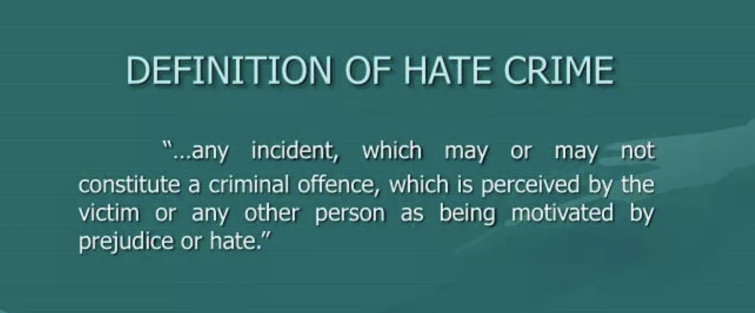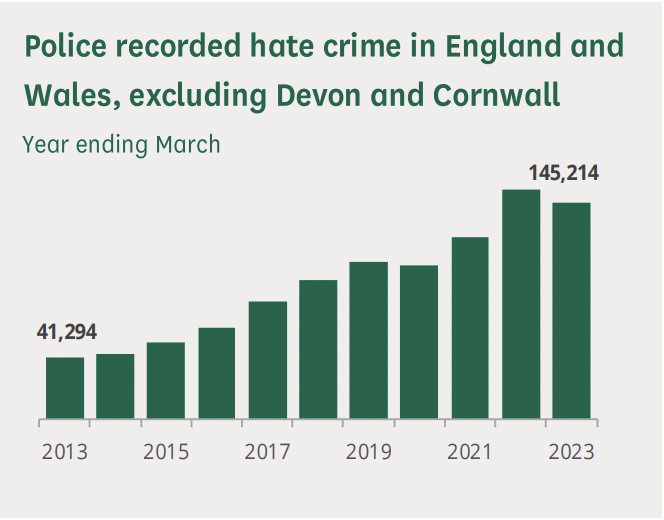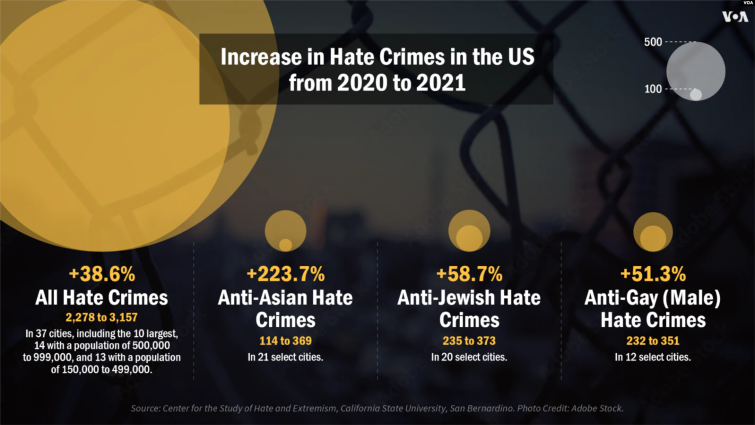Hate crime is one of the fastest growing online threats – and one of the least examined and investigated. Although hate crimes take place all over the internet, little is done to prevent them, and the relevant people and institutions react only after it's too late.
The United States Department of Justice defines a hate crime as any crime motivated by bias against race, color, religion, national origin, sexual orientation, gender, gender identity, or disability.
In 2021, CNN reported that hate crime has reached the highest levels in the past 12 years, with the FBI collecting evidence of over 10,000 people reporting a hate crime in the US alone.
Have you ever asked yourself if there is a correlation between online hate speech and real world crime? Read on for our rundown of statistics and facts to find out the answer to this and other pressing questions. We'll also share tips on how you can combat hate speech online.

1. More than 200,000 hate crimes occur in the US each year
The official FBI figure for reported hate crimes in the US has ranged between 7,000 to 8,000 in the past few years. However, the 2019 Hate Crime Statistics by the Bureau of Justice suggests that, in reality, this number is much higher – estimated to be over 200,000 per year.
According to its findings, of the police agencies who responded, 86% didn't record a single hate crime in 2019. Since having zero hate incidents isn't very realistic, it's clear that reporting processes are failing, and so are official hate crime numbers. It could be that the US police departments are having difficulties in classifying cases, especially since certain hate crimes are hard to prosecute.
2. In the UK, police recorded the highest number of hate crime reports ever
Meanwhile, the official number of recorded hate crime offenses in the UK seems somewhat more realistic. Excluding Devon and Cornell, the UK police recorded 145,214 hate crime cases in 2023 – the highest number of incidents in years.

3. Most hate crimes in the US are motivated by race, ethnicity, or ancestry
Among a total of 8,263 hate crime reports the FBI received in 2020, almost two-thirds (61.8%) were classified as "single-bias" incidents motivated by race/ethnicity/ancestry bias. Of the remaining incidents, 20% were motivated by sexual orientation bias, 13.3% by religious beliefs, 2.7% by gender identity, 1.4% by disability, and approximately 0.7% by gender. The overall number of reported hate crimes increased by 13% between 2020 and 2021.
4. Anti-Asian incidents jumped by 224% in the US
Among all the other negative security trends, anti-Asian assaults have risen sharply since the COVID-19 pandemic in early 2020. Most community activists and experts agree the media made China infamous by blaming it for the release of the virus, and the detrimental rhetoric that followed took a massive toll. What's more, this wave of hate has extended to the whole of Asia.
Incidents categorized as anti-Asian hate crimes increased by 224% in 2021, with 369 incidents reported in 20 of the biggest US cities. At the same time, anti-Jewish and anti-gay incidents increased by over 50%, to 373 and 351 incidents, respectively.

5. 74% of UK online hate crimes involve race
In recent years, the majority of hate crime victims in the UK were, for the most part, motivated by racial factors – nearly 74% in fact. Approximately 15% were motivated by the victims' sexual orientation, 8% were against people with disabilities, and 5% were motivated by religion.
*As you may have noticed, the combined data in the chart below exceeds 100%. That's because some of the crimes had more than one motivating factor.
6. Hate crime saw a decline from 2008 onwards and started rising again in 2015
For a short period between 2008 and 2014, hate crime was in decline (except in 2013), however, the number of hate crime incidents increased again in 2015, and has been steadily rising since. The latest Justice of Crime statistic shows 11,288 single-bias incidents in the US, the highest number in over a decade.

7. Almost 60% of hate crimes in Canada are motivated by race or ethnicity
According to Statistics Canada, Canada's national statistical office, over half of the hate crimes in the country are racially motivated. In 2020, a total of 2,669 hate crimes were reported to police, out of which 1,594 (59.7%) were categorized as racially or ethnically motivated. Religion is the second most common motif for hate assaults in Canada, with 515 victims (almost 20%), and sexual orientation is third, with 259 (approximately 10%) official reports. Other motives included bias against language, disability, sex, and/or age.
8. 1 in 5 Canadians have experienced online hate
A 2021 survey on Online Hate and Racism by the Canadian Race Relations Foundation found that every fifth respondent has experienced hate, harassment, or violence online. What's more, out of 2,000 Canadian people surveyed, nearly half (47%) have witnessed or personally experienced racist comments/content on the internet, 38% have seen or faced homophobic assaults, and 33% have seen or faced sexist comments/content.
9. Over 60% of the LGBT+ population in the UK have experienced online harassment
The Hate Crime Report 2021 by Galop revealed that, among 1,166 respondents of the survey, nearly two-thirds (64%) had experienced anti-LGBT+ violence or abuse. The survey also showed that 9 in 10 victims (90%) faced verbal abuse, 3 in 10 (29%) had suffered physical violence, and 2 in 10 (17%) had experienced sexual violence. Furthermore, 60% of victims said they experienced harassment online, and 16% said they experienced violence or abuse daily.
10. Most LGBT+ hate crime victims don't report the incident to the police
The same report shows that nearly 73% of LGBT+ victims in the UK didn't report the abuse they experienced to the police. Over half of the victims who didn't report the harassment believed that the police wouldn't take any action even if they reported the case. 31% thought the police wouldn't be able to do anything, and 38% said the abuse happened too often to be reported. Among those who filed a police report, 37% were dissatisfied or very dissatisfied with the response they received.

11. Hate speech among children and teens increased in early 2020
Children nowadays spend considerably more time indoors and online, especially since the start of the COVID-19 lockdowns. The usage of communication/gaming platforms and social media apps among youngsters has significantly increased as well. L1ght found that hate speech among children and teens has increased by 70% since the COVID-19 outbreak, and there has been a 40% increase in perceived toxicity among kids on Discord and other gaming platforms.
12. Online hate speech and physical crimes are correlated
Several studies have drawn a correlation between online hate speech and physical hate crime. A 2019 study by academics from Cardiff University's HateLab has concluded that increased hate speech against minorities on social media can significantly boost physical-world crimes against those groups.
The study compared the number of "hate tweets" and the real-time crime data in the same areas of London, and found out that the number of crimes (especially those with a racial or religious motive) had increased in line with the increase in harmful tweets.
Another significant study, requested by the LIBE committee and approved by the EU Parliament, reasoned that these tweets threatened individual rights, human dignity, and equality – often resulting in even more tensions between social groups, and endangering peaceful coexistence.
13. Facebook took action on more than 15 million instances of hate speech Jan – Mar 2023
According to Facebook's Community Standards Enforcement Report, which is released every quarter, online hate speech peaked in Q1 2021, with over 31 million disciplinary actions taken in response. Q3 of 2021 saw a decrease in detected and actioned hate speech instances on Facebook, with 17.4 million reported posts/messages.
The first quarter of 2023 also saw a decline in actioned hate speech, with approximately 15.1 million of instances of harmful content being restricted. However, these figures are still significantly higher when compared to Q1 2019, when actions were taken against 4 million pieces of hateful content.

14. Facebook is able to detect 95.6% of hate speech
In 2021, the largest social media conglomerate announced that "AI now proactively detects more of the hate speech removed from Facebook". The latest Community Standards Enforcement Report supports this claim with its interactive graph, which shows that over 95.6% of instances of hate speech on Facebook were found and flagged by the platform itself in Q1 of 2023 – before they were reported by users. What's more, in Q2 2021, Facebook managed to detect as much as 97,6% of all hate speech spreading through the platform.
15. Levels of Hate Speech remain relatively consistent on Facebook
Beginning in 2023, of every 10,000 content views on Facebook, approximately 2 or 0.02% would contain hate speech, as recorded by the Meta Transparency Center. This is only a slight improvement compared to the beginning of 2021 when 0.05% to 0.06% of reviewed Facebook content involved hate speech.
16. Twitter actioned 77% more accounts for violating its hateful conduct policy in 2020
Twitter has been updating its hateful conduct policy at least once a year for the last few years. The second half of 2020 saw a 77% increase in the number of accounts actioned for violations of Twitter's hateful conduct policy. Over 10,320,924 accounts were challenged for hate speech from July to December that year, out of which 1,126,990 accounts were suspended.
17. In Q1 2023, TikTok removed over 100 million videos, 6% of which were for online harassment and bullying
Although 100 million videos sound like an awful lot, being globally popular as it is, with billions of videos posted each month, TikTok on average removes less than 1% of all posted content. Of the videos removed for violating its policies and guidelines, approximately 6% contained hateful behavior such as harassment and bullying. Between January and March 2023, Tik Tok removed over 6 million videos for violating its hate speech policy.
18. Racially and religiously aggravated offenses are more likely to result in a charge or summons
According to the official Hate Crime Statistics from the House of Commons library, racially and religiously aggravated offenses have, on average, a 4% greater chance of resulting in a police charge or court summons. The difference in the percentage (with and without racially and religiously aggravated offenses) goes up to 7% for offenses related to causing public fear, up to 4% for offenses involving assault with or without an injury, and 2% difference for offenses with criminal damage.

19. Most online hate crimes in the UK (80%) involve violence against the person
The same Hate Crime Statistics report revealed that most online hate crimes in the UK in 2021 involved violence against the person – a whopping 80%. This type of online violence was mostly conveyed through malicious messages. Transgender people were the most common victims of online hate crimes categorized as violence against a person – 10% of all victims. Interestingly, violence against the person was much less motivated by race (4%).
20. At least three US states have weak hate crime laws or no hate crimes at all
For a country so proud of its democracy, the US has hugely uneven hate crime laws. Three US states have no hate crime laws at all – Wyoming, South Carolina, and Arkansas. Truth be told, the latter two have made some efforts in the past to change that, with lawmakers in Arkansas and South Carolina introducing bills against certain hate crimes, but with little luck in getting them made into law.
On the other hand, some states do have hate crime laws on paper, but they haven't been very effective in the past. For example, the district attorney of Salt Lake County called Utah's hate crime statute worthless; and Puerto Rico and the US Virgin Islands have their own hate crime laws, but they are complex and inconsistent.
How to combat hate crimes?
Fighting hate crimes is both extremely necessary and extremely difficult. Millions of instances of hate speech happen each day both online and offline, and the numbers are not likely to drop any time soon. Some of the main obstacles preventing this from happening are a lack of awareness and people underestimating the scale of the problem.
That being said, a significant improvement in hate crime statistics can only be achieved when everyone (or, at least, most people) accepts that any sort of biased, hate-motivated speech or behavior is, and should be treated like, a crime! In case you have ever wondered what you can do to combat hate speech, here are a few suggestions.
Report hate crimes and encourage others to do the same
Whether it happens to you or somebody you know, whether it occurs online or in person – hate crime must be reported! If you ever feel you have been targeted because of your race, ancestry, religion, sexual orientation, or any other personal trait or belief, you absolutely should contact the police and report the offense.
Depending on the seriousness of your case, you may want to inform officials orally or make an official report. If you opt for the latter, make sure to get a confirmation receipt, the incident number, or a copy of your report – you may need it in the future.
Likewise, if you know somebody who's going through online harassment or you've seen a person being exposed or threatened in public, encourage them to make a police report. Alternatively, take a screenshot and, at least, warn the platform's administrators about it.
Notify relevant organizations
Every country has organizations set up to fight hate, so don't hesitate to reach out to them. Research who is the best for the job in your area or state, and call or message them. You've nothing to lose by reaching out. In the worst-case scenario, they won't be able to help you directly, but they should be able to point you to somebody that can.
Raise the awareness that hate speech is a crime
As mentioned above, lack of social awareness is one of the biggest problems with hate speech. But, don't just assume there's nothing to be done and turn a blind eye to it, especially when there's plenty each of us could do.
For starters, we can talk to our family and friends about the issue. Bring your best arguments to convince them that hate speech is not just an online problem, but can easily escalate into an actual life-threatening situation. There are even online campaigns you can join which are making a difference bit by bit.
Treat social media hate speech the same as any offline crime
Social media hate speech is the same as any other crime and should be treated as such. Social platforms are accountable for online incidents, and so you should report any disturbing or alarming tweets, YouTube videos, Instagram, or Facebook posts you see. Try to be as specific as possible about the offensive content you saw – where you saw it, who was targeted, what exactly is was that you found offensive and why, etc.
Counterbalance it
You may feel that there's no positive message strong enough to make a difference in the face of the rising torrent of hate online, so there's no point in even trying – but you'd be wrong. Spreading positive vibes may be slower and have less direct impact than spreading hate, but every single act of kindness, no matter how small, makes a change.
The same goes for positive messages of support and tolerance. They may not reach thousands of people in a day, but each of them can make a world of difference for at least a few people out there – and that's something significant we can all do!
